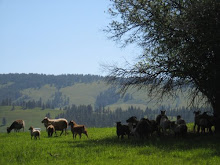This information is from http://www.seedsave.org/
Beans, Lettuce, Peas, Peppers and Tomatos offer the beginning seed saver the best chance for successful seed saving. They produce seed the same season as planted and are mostly self-pollinating, minimizing the need to be mindful of preventing cross-pollination.
Bean
HARVEST: Allow pods to dry brown before harvesting, about six weeks after eating stage. If frost threatens, pull entire plant, root first, and hang in cool, dry location until pods are brown. PROCESS: Small amounts of pods can be opened by hand. Flail larger amounts. Remove large chaff by hand or fork. Winnow remaining particles.
Lettuce
HARVEST: Some outside leaves can be harvested for eating without harming seed production. Allow seed heads to dry 2-3 weeks after flowering. Individual heads will ripen at different times making the harvest of large amounts of seed at one time nearly impossible. Wait until half the flowers on each plant has gone to seed. Cut entire top of plant and allow to dry upside down in an open paper bag.
PROCESS: Small amounts of seed can be shaken daily from individual flowering heads. Rub with hands to remove remaining seeds. If necessary, separate seeds from chaff with screens.
Peas
HARVEST: Allow pods to dry brown before harvesting, about four weeks after eating stage. If frost threatens, pull entire plant, root first, and hang in cool, dry location until pods are brown. PROCESS: Small amounts of pods can be opened by hand. Flail larger amounts. Remove large chaff by hand or fork. Winnow remaining particles.
Pepper
HARVEST: Harvest mature, fully-ripe peppers for seed. (Most bell peppers turn red when fully mature.) If frost threatens before peppers mature, pull entire plant and hang in cool, dry location until peppers mature.
PROCESS: There are two methods, dry and wet, to process pepper seeds. The dry method is adequate for small amounts. Cut the bottom off the fruit and carefully reach in to strip the seeds surrounding central cone. In many cases, seeds need no further cleaning. To process the seed from large amounts of peppers, cut off the tops just under the stem, fill a blender with peppers and water and carefully blend until good seeds are separated and sink to bottom. Pepper debris and immature seeds will float to the top where they can be rinsed away. Spread clean seeds on paper towel and dry in cool location until seed is dry enough to break when folded.
Tomato
HARVEST: If possible, allow tomatoes to completely ripen before harvesting for seed production. Unripe fruits, saved from the first frost, will ripen slowly if kept in a cool, dry location. Seeds from green, unripe fruits will be most viable if extracted after allowing the fruits to turn color.
PROCESS: Cut the tomato into halves at its equator, opening the vertical cavities that contain the seeds. Gently squeeze out from the cavities the jelly-like substance that contains the seeds. If done carefully, the tomato itself can still be eaten or saved for canning, sun-drying or dehydrating. Place the jelly and seeds into a small jar or glass. (Add a little water if you are processing only one or two small tomatoes.) Loosely cover the container and place in a warm location, 60-75° F. for about three days. Stir once a day. A layer of fungus will begin to appear on the top of the mixture after a couple of days. This fungus not only eats the gelatinous coat that surrounds each seed and prevents germination, it also produces antibiotics that help to control seed-borne diseases like bacterial spot, canker and speck. After three days fill the seed container with warm water. Let the contents settle and begin pouring out the water along with pieces of tomato pulp and immature seeds floating on top. Note: Viable seeds are heavier and settle to the bottom of the jar. Repeat this process until water being poured out is almost clear and clean seeds line the bottom of the container. Pour these clean seeds into a strainer that has holes smaller than the seeds. Let the excess water drip out and invert the strainer onto paper towel or piece of newspaper. Allow the seeds to dry completely (usually a day or two). Break up the clumps into individual seeds, label and store in a packet or plastic bag.
Subscribe to:
Post Comments (Atom)

No comments:
Post a Comment